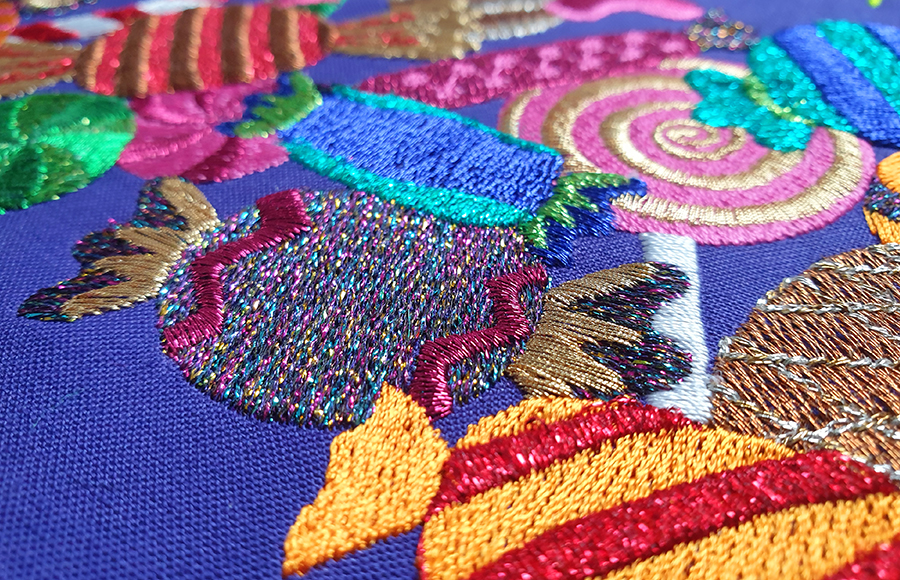For those who’ve steered clear of metallic embroidery thread because of the whispers of challenges, I totally get it. I was once in your shoes. But guess what? The allure of adding that glittery touch to my creations drew me in. And the results? Absolutely dazzling! ✨
Admittedly, my initial attempts weren’t smooth. But with a few metallic thread embroidery tricks up my sleeve, adding that sparkle became second nature.
Are metallic threads giving you a tough time? Dive into this comprehensive guide and master the art of embroidering with metallic thread flawlessly.
Decoding Metallic Threads
Did you know? If you dissect a metallic thread, you’ll uncover two distinct parts. These threads are crafted with a metal foil layer wound around a robust nylon or polyester core. While you can separate the layers manually, your machine can mistakenly do it too if it’s not calibrated correctly. Ideally, the thread should glide smoothly between your fingers, or it’s likely to misbehave in your machine.
Why can metallic threads be tricky?
Visualize the rapid dance of your machine’s needle and the impact on that fragile metal layer. Friction against fabric, needle, or even the machine can cause the metal to peel off. And the natural twistiness of metallic threads? That can be a recipe for tangles, especially when it interacts with the machine’s tension disks. This results in just the core threading through your fabric, often leading to a mess when the core ultimately breaks.
Diverse Metallic Threads
The spectrum of metallic thread colors is broad and beautiful! Beyond the classic gold and silver, you’ve got stunning shades like pink, turquoise, and even multi-colored threads. It’s wise to experiment with different brands, as machines can have preferences. Personally, I’ve had good experiences with both Thread Nanny and KingStar metallic threads. And while the standard weight is 40 wt, exploring other weights can open up new creative avenues.
Golden Tips for Metallic Thread Embroidery ✂️
- Needles: Switch to metallic or topstitching needles. These have enlarged eyes to reduce friction and ensure smoother stitching with metallic threads. Depending on your fabric and thread weight, choose either an 80/12 or a 90/14 needle.
- Thread Stand: To avoid excessive curling, opt for a vertical thread setup. I use an Embroidex stand which works wonders. The distance between the stand and machine matters; the greater it is, the better the thread behaves.
- Thread Nets: Commonly used with serger threads, these help in even feeding and reduce tangling. Ensure they cover the entire spool for maximum benefit.
- Stitching Speed: A slower pace can reduce the chances of the thread breaking. My go-to speed with metallics is 350 spm.
- Stabilizers: Select based on design and fabric type. Softer stabilizers like cut-away or no-show mesh are preferable. Stay away from adhesive ones that might affect the thread’s outer layer.
- Thread Tension: Adjusting the machine’s tension might be necessary to achieve perfect results. This varies based on multiple factors, so gradual tweaks are advisable.
- Design Choice: Dense designs might be challenging with metallic threads. I often finish off with metallic threads for a final touch of sparkle.
- Machine Maintenance: Clean the bobbin case and check the upper thread path. Sometimes, a simple cleanup can solve many issues.
- Thread Cutter: If you use metallic threads often, consider disabling automatic thread cutting. For trimming jump stitches, sharp tweezers and scissors are handy.
Troubleshooting Metallic Threads
If you notice frayed threads that don’t break instantly, you’ll find areas with compromised stitch quality. To remedy this, simply restitch that particular section. Navigate on your embroidery machine to revert to the point of fraying and restart your stitching. Voila!
Essential Details at a Glance:
| Aspect | Recommendation |
|---|---|
| Thread Type | Metallic |
| Needles | Metallic or Topstitching (80/12 or 90/14) |
| Stitching Speed | 350 spm |
| Stabilizers | Cut-away or No-show mesh |
| Thread Tension | Adjust based on machine and fabric |
| Design Choice | Less dense designs |

